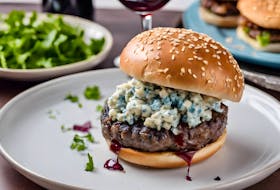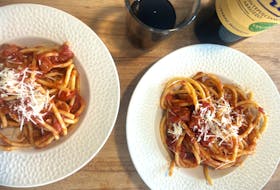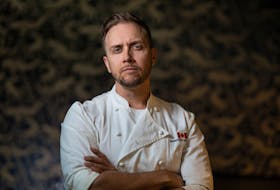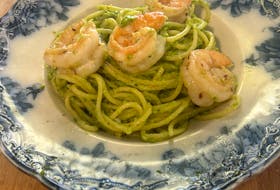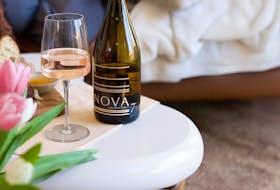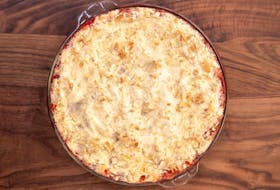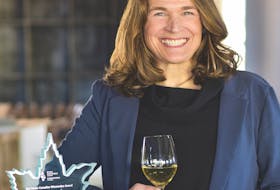Staghorn sumac, with its clusters of fuzzy, crimson berries, makes a beautiful iced tea — colourful, tart and refreshing. Adding a distinct citrus flavour, this wild edible grows all over North America and can be identified by its serrated leaves — which turn a vivid gold and scarlet in the fall — directly facing each other along an extended stem, says Shawn Adler, a chef and lifelong forager.
You’ve likely passed this plant countless times, growing along major highways or gravel country roads. For his sumac sun tea, Adler adds river mint, crushed blueberries and cherries, and a juicy Ontario peach he tears apart with his hands.
He learned how to identify wild edible plants from his mother, an Anishinaabe member of Lac des Mille Lacs First Nation. Adler has memories of visiting their reserve northwest of Thunder Bay most summers as a child, fishing for pickerel with his great-uncle and cutting poplar wood with his great-aunt, which she told him was the best kind to make fry bread with because it burns at the ideal temperature.
The chef-owner of Toronto’s Pow Wow Cafe and The Flying Chestnut Kitchen in Eugenia, Ont., Adler shares his knowledge in the award-winning documentary series Forage (CBC Gem), a collaboration with filmmakers Jesse McCracken and Samuel Larson. “(Foraging) is a way that I can stay connected to my community and culture through doing something that people from my First Nation have always done,” he says.
“My mom was always telling me stories, too. She went to residential school and said, ‘As kids we knew everything that we could eat around the school.’ Because the school never fed them enough, they’d eat everything that was possibly edible in the wild just to sustain themselves on top of the crappy and very little food that was provided. Rose hips and chokecherries — she’d always point out everything that they would eat as children.”
Adler encourages people to look at their natural surroundings differently. As with staghorn sumac, plants that some may deem ornamental or weeds to be eradicated, he considers food. Through demonstrating how to identify and harvest entry-level wild plants — burdock, wild ginger, puffball mushrooms — and sustainable harvesting practices and creative uses, he hopes to expand people’s idea of what food is.
Even in urban environments, wild edibles flourish if you know where to look for them. In an episode of Forage , Adler leaves his home in Southern Ontario’s Grey County to illustrate foraging opportunities in downtown Toronto. With restaurants in both places, “I’m floating in two different canoes. I’ve got one foot in the city, one foot in the country. I’ve got a great balance,” he says.
“It’s pretty amazing how we’re programmed in Canadian society to think all of our food comes out of a grocery store aisle. Whereas there’s so much food that’s available, even in the city. Like lamb’s quarters, plantain and garlic mustard — the list goes on and on of things that are edible, quite delicious and healthy. But in this country especially, they aren’t commercially grown and sold. So our diet is really dictated by what is sold by the big box stores,” Adler adds, laughing.
The beauty of the edible landscape is on full display in and around his own backyard in Grey County, Ont. Each of the four episodes of Forage is dedicated to a season. Spring is Adler’s favourite time to be out in the woods or on the water, harvesting a bounty of wild leeks, morel mushrooms, fiddlehead ferns and rainbow trout. Now, in high summer, the bush is thick and green as twining vines and “humongous” burdock leaves take over the paths. Wild raspberries and black raspberries are ripe, he says, and wild grapes and chokecherries are almost ready to be picked.
Each wild edible has its own set of criteria and rules when it comes to responsible foraging, says Adler. But there are three key general guidelines to follow: always harvest with a knowledgeable guide, make sure you have permission to harvest from the land, and never over-harvest.
“Every spring you hear stories about wild leeks and fiddleheads especially, because these are two wild edibles that chefs really prize, and foragers are going out and over-foraging. Certain areas near big cities are really being depleted because people are completely decimating whole crowns of fiddlehead ferns, and they don’t come back,” says Adler. “Harvesting sustainably is really important so that you’re leaving something for future generations and for the animals.”
As a chef, Adler appreciates the ability to supplement everyday ingredients with wild foods as a means of tapping into seasonality and highlighting products outside of the mainstream. When we spoke, he was harvesting elderflowers for his side project, Wildside Soda Company, — in which he infuses pop with Indigenous ingredients such as cedar and sweetgrass — and blue chicory flowers to garnish his Indian tacos, a dish Pow Wow Cafe is known for.
“There’s so much available and people are just not aware. They don’t have the knowledge that we’re surrounded by food. It just takes a little bit of a different way of looking at things,” says Adler.
“There are chefs all over the world now that are really taking things to the next level (with foraged foods). Or maybe to a previous level, more accurately, in that we’re appreciating things that have been put to the wayside and maybe forgotten. Flavours that have been just under the surface — and overlooked by commercial growers — that really add excitement to your palate and plate.”
Copyright Postmedia Network Inc., 2020

